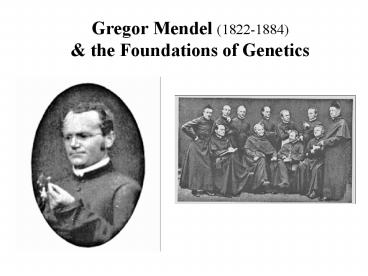Gregor Mendel (1822-1884) - PowerPoint PPT Presentation
1 / 16
Title:
Gregor Mendel (1822-1884)
Description:
Gregor Mendel (1822-1884) & the Foundations of Genetics Mutation Point Mutations Change in one base pair - may or may not change amino acid, changed amino acid may or ... – PowerPoint PPT presentation
Number of Views:116
Avg rating:3.0/5.0
Title: Gregor Mendel (1822-1884)
1
Gregor Mendel (1822-1884) the Foundations of
Genetics
2
MutationPoint Mutations
- Change in one base pair - may or may not change
amino acid, changed amino acid may or may not
change protein conformation - Spontaneous, but also increased by radiation,
heat, chemical mutagens - Rate Infrequent one in a billion bases
AATAAGAA
AATATGAA
3
Three Point Mutations
Deletion
AATAAGAA
AATAGAA
Substitution
AATAAGAA
AATATGAA
Insertion
AATAAGAA
AATAAAGAA
4
Three Genetic Mutations
Deletion
AATAAGAATGGG
AATAGAATGGG
Substitution
AATATGAATGGG
AATAAGAATGGG
Insertion
AATAAGAATGGG
AATAAAGAATGGG
5
Chromosomal Mutations
- Chromosomes can be duplicated, portions can be
translocated to a different chromosome or
inverted on the same, or deleted - Usually has profound consequences - sterility or
worse - Common, e.g. Downs syndrome 1700 births
- Major mode of instantaneous speciation in
self-fertilizing or inbreeding species,
especially plants
6
(No Transcript)
7
Human genomes are complex, but .
- Only 1/3 more genes than a worm
- - Genes like components in assembly lines?
- Many more harmful mutations per generation
- Much less coding DNA (rest junk or spacer or ?? )
8
Genetic Load
- For humans, estimated by reduced fertility and
increase in birth defects associated with
conceptions between relatives - 4 recessive lethals per individual, more than one
new lethal per generation - In womens eggs, chromosomal defects in eggs
increase with age - In mens sperm, DNA sequence changes increase
with age - In outbred human conceptions
- 70 of conceptions never come to term
- 2 per 1000 live births have genetic defects
9
What Changes Gene Frequencies?
- Mutation
- Genetic drift (random change in small pops)
- Non-random Mating
- Migration Gene Flow
- Natural Selection
10
Purifying Selection
- Dominant or Sex-linked (X or Y) deleterious
mutant alleles eliminated rapidly by natural
selection - Recessive autosomal deleterious mutant alleles
reduced slowly by selection - heterozygotes protect recessive deleterious
mutant alleles - never eliminated a mutation - selection
equilibrium is reached
11
Stabilizing Selection decreases variation,
doesnt shift mean
Mean
Old Mean
Frequency
Frequency
Trait value
Trait value
Parents
Offspring
12
Directional Selection may reduce variation,
shifts mean
Mean
Old Mean
Frequency
Trait value
Parents
Offspring
13
Disruptive Selectionincreases variation, may
shift mean
Mean
Old Mean
Frequency
Trait value
Parents
Offspring
14
Sexual Selection
15
Forms of Sexual Selection
- Intrasexual (usually male-male competition)
- Weapons for within-sex competition
- Intersexual (usually females choosing males)
- Ornaments or signals to attract choosy mates
- Why are animals choosy aesthetic preferences
(Darwins hyp.) or signals indicate mate quality?
16
Consequences of Sexual Selection
- Drives species away from the ecological optimum
- Major cause of sexual dimorphism via disruptive
selection since ornaments are an advantage in
only one sex, there is selection for modifiers
that lead to expression in one sex only


















![Gregor Johann Mendel (July 20, 1822[1] PowerPoint PPT Presentation](https://s3.amazonaws.com/images.powershow.com/6267679.th0.jpg?_=20150314042)












